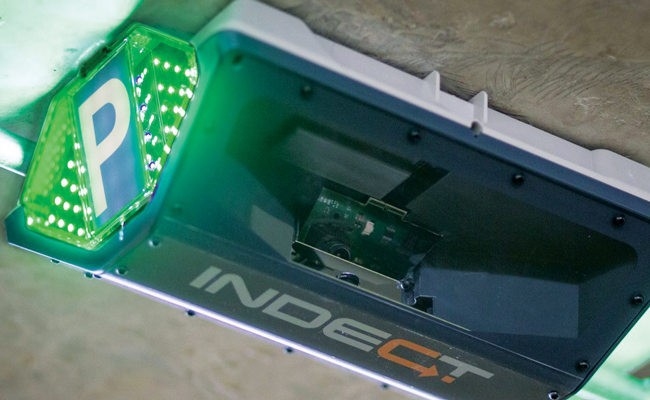Maximizing Revenue Through Dynamic Parking Pricing

Sensors, software and apps make dynamic pricing feasible — and profitable.
PARKING IS an important source of revenue for many owners of commercial buildings and complexes. Yet it can be difficult to determine whether parking facilities are performing as well as they should. Many owners find themselves managing this valuable asset without a mechanism for fully realizing that value. This is particularly true for downtown parking facilities.
The problem: Unlike many other products and services, it has always been difficult to apply market-driven pricing to parking. Until recently, there hasn’t been a good way to measure parking demand and adjust prices as demand rises and falls. Property owners and their parking operators have traditionally been forced to rely on historical data to predict future demand, then set prices accordingly. But no matter how much data you have about past parking demand, it’s impossible to know for certain how much demand there will be in the future.
A Technological Solution
The good news is that the technology that has transformed the parking industry in recent years is making dynamic pricing possible.

Tim Flanagan
The key to success begins with the parking guidance sensors that have become increasingly popular over the past few years. One of the key roles of those sensors has been to monitor utilization. The most visible manifestation of this is the series of lights that indicate to drivers whether a particular space is available. Typically, a green light indicates that the space is available, red means it’s occupied and blue means the space is reserved for handicapped-accessible parking.
These same sensors can also work in conjunction with software to analyze when and how often spaces are used, to help owners and operators better manage their facilities. That software can be customized to continuously monitor occupancy levels and automatically modify pricing in real time. If occupancy rises above a certain level, the price rises accordingly. If it falls, the price drops. Owners and operators can base their pricing on use, rather than on guesses about how full or empty their facility will be on a given day.
Of course, as with parking guidance systems, communication is required for the dynamic pricing system to work. Just as the sensors communicate in real time with signs at facility entrances so they can tell parkers how many open spaces are available on each floor, the system must also communicate how much parking costs at that exact moment. Drivers must not enter a parking lot or garage expecting to pay one amount, only to be charged more when they leave.
These technologies enable the use of dynamic pricing in any parking facility. Typically, ground-based sensors are used in outdoor lots, while ceiling-based sensors are hung above parking spaces in garages.
Good News
Dynamic pricing is good news for parking owners and operators; it enables them to generate maximum market-rate revenue in their parking assets. When the first gateless off-street automated dynamic pricing solution was introduced last spring in downtown Los Angeles, the owner began benefitting immediately. Over the first two months of implementation, revenues increased by 100 percent each month, before settling at around 35 percent per month. When the owner factored in decreased labor and associated costs from directed enforcement and the ability to manage the facility from a central location, profits increased over 50 percent per month. As this example demonstrates, while the installation of a sensor-based system requires an initial investment, that investment can pay for itself in just a matter of months. In this case, installation cost approximately 5 percent of annual revenue and ROI took two months.
Interestingly, business at this facility has actually picked up since the owner installed the dynamic pricing package. Drivers seem to appreciate knowing that the rates they are being charged are based on the actual value of the space, and not some arbitrary number.

Dynamic pricing begins with parking guidance sensors that measure utilization and transmit that data to software that can automatically adjust pricing as occupancy rises and falls.
The benefits also extend to drivers. Those who typically park in low-utilization lots or garages will no longer pay more than they should for parking, because the price of parking in those facilities will go down. The sensors that are managing the system continue to guide drivers into open spaces, which makes the entire parking experience more convenient and pleasant.
Added Value
Moving forward, these systems will be able to offer even more amenities for drivers. For instance, owners and operators can offer parker loyalty programs through smartphone apps. These apps may include features such as preferred parking and discounts, as well as access to added services such as auto detailing. The features can be customized to the unique desires and requirements of customers at each parking facility which, in turn, can increase connectivity among owners and operators and their customers. The apps will also be able to guide parkers back to their vehicles if they forget where they parked.
These benefits will grow exponentially in the future. As the era of connected cars and self-driving vehicles approaches, sensor-based networks will be a key to the success of these efforts. They will be the tool that connects all of a community’s parking spaces to the transportation grid.
Of course, not all sensor systems can manage dynamic pricing. While accuracy is essential in any type of parking guidance system, it’s particularly important when the price of parking is being adjusted on the fly. Inaccurate systems can cost owners and operators thousands of dollars by improperly dropping prices when occupancy is too high. With dynamic pricing, anything below 99 percent accuracy is unacceptable.
Dynamic pricing can provide extraordinary benefits to building owners who rely on parking revenues. It’s a concept whose time has come, now that the necessary technology is available.
Tim Flanagan, managing director, Sentry






